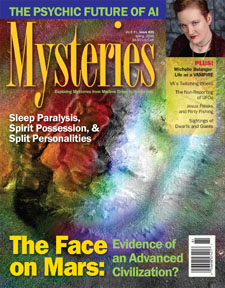|
 In Association With
Mysteries
Magazine!
In Association With
Mysteries
Magazine!
3/14/08 #460
http://www.conspiracyjournal.com
Subscribe for free at our subscription page:
http://www.members.tripod.com/uforeview/subscribe.html
You can view this newsletter online at:
https://uforeview.tripod.com/conspiracyjournal460.html
It doesn't matter if you lock
your doors and throw away the keys - THEY know you are home! Got a
computer? THEY know you are online! And THEY know that you have just
received another brain-crunching issue of the weekly newsletter of all
the weird stuff and conspiracies that THEY DON'T WANT YOU TO KNOW - THE
CONSPIRACY JOURNAL! So read it quickly before THEY come knocking on
your door to take you away! Information is POWER!
This week Conspiracy Journal
brings you such creature-feature stories as:
- Gulf
War Syndrome Firmly
Linked to Chemical Exposure
-
- A Brief History Of Time Machines -
- Wisconsin - Where the 'Bear-Wolf' Roams -
-
Weird 'Gnome' Caught on
Video -
AND: 'Magnetic Boy' Keeps
Crashing Computers
All these exciting stories and MORE
in this week's issue of
CONSPIRACY JOURNAL!
~ And Now, On With The Show! ~

INCREDIBLE
MYSTERIES OF THE BIBLE
WHAT CAN WE
REALLY BELIEVE ABOUT SCRIPTURE?
BIBLICAL STORIES - TRUTH? or FICTION?

The Great Flood and
Other Myths and Legends of the Old Testament
Here is unequivocal proof that "Noah's Flood" actually occurred and
that the fall of the Tower of Babel did cause chaos, mass hysteria and
the confusion of multiple tongues to prevail among humankind.
Hundreds of Biblical accounts accepted as gospel by "true believers"
have come under continued attack by the secular community to the point
where it is difficult to sort out the factual nature of God's works.
The author of this book, spent a good part of his life scoffing at the
Christian world only to accumulate records from all over the world
which show the universality of creation, the great flood, man's fall
from grace, as well as the collapse of the Tower of Babel.
Frazer presents astounding proof that a global flood has left the
strongest single historical imprint upon all of humanity, no matter
where on the globe folks had later moved and settled. In fact, amongst
120 different tribes in North and South America, no one tribe exists
that has not related distinct or vague traditions of such a calamity.
Here also are stories told by many cultures of the down fall of the
Tower of Babel and the Creation of Man.
This book contains a wealth of Biblical evidence for believer, scholar
and non-believer alike!
This fascinating book is now available for
the
special price of only $18.95
BUT WAIT! If you order right now we will include this FREE
DVD:
On the Trail of the Living
Dinosaurs!
Do dinosaurs still roam the Earth? Did they live during the timeof
Noah? Is the theory of evolution just that...an unproven theory?
Does the holy text speak of creatures thought to be extinct for
hundreds of thousands of years as being alive during the times of both
Old and New Testaments? Learn how the environment of the original
creation vastly differed from ours today and how this allowed humans to
live for over 900 years,
producing huge plants and animals, and provided conditions for the
advent of the dinosaurs. $15.00 value. Yours free when you order this
new Inner Light title from Conspiracy Journal.
So don't delay, order your copy of The Great Flood and Other
Myths and Legends of the Old Testament today for only $18.95
plus $5.00 for shipping - A GREAT PRICE!
NOW
-Order Through PayPal
| The
Great Flood and Other Legends of the Bible |
|
|

You can also phone in your
credit card orders to Global Communications
24-hour hotline: 732-602-3407
And as always you can send a
check or money order to:
Global Communications
P.O. Box 753
New Brunswick, NJ 08903
NOW ON
SALE!
MYSTERIES MAGAZINE #20

In
This Incredible Issue:
Sleep Paralysis, Split
Personalities,
and Spirit
Possession
Michelle Belanger: Life as a
Psychic Vampire
Science and Psychism:The Future
of Artificial Intelligence
From Microbes to Monoliths:The
Search for Life on Mars
PLUS: From Dwarfs to Giants:
Sightings of Unusually Sized Humans
News
Blackouts and the Non-Reporting of
UFOs
The Mysterious Disappearance of Agatha Christie
College Campus Urban
Legends:Tall Tales that Students Tell
Moonville, OH:A Haunted Railroad
Town
Virginia’s Twitching Illness and
Other Mass Maladies
The Children of God:Jesus Freaks
and Flirty Fishing
Get
your issue TODAY at your favorite bookstore or magazine stand.
-
AFTER ALL THIS TIME DEPARTMENT -
Gulf War Syndrome Firmly
Linked to Chemical Exposure

Nearly two decades after veterans of the 1991 Gulf War came home
complaining of odd illnesses, enough evidence has been gathered to
determine that many of them were sickened by chemical exposure, a study
has concluded.
And some of the damage was likely caused by pills prescribed to protect
against the use of nerve gas and pesticides used to control sand flies,
according to the study published Monday in the Proceedings of the
National Academy of Sciences.
While the military has subsequently stopped using the pills, the
pesticides continue to be used in agriculture and for pest control in
homes and offices in the United States and around the globe.
"Enough studies have been conducted, and results shared, to be able to
say with considerable confidence that there is a link between chemical
exposure and chronic, multi-symptom health problems," said study author
Beatrice Golomb of the University of California San Diego's school of
medicine.
"Furthermore, the same chemicals affecting Gulf War veterans may be
involved in similar cases of unexplained, multi-symptom health problems
in the general population."
Golomb examined the results of scores of studies looking at the health
impact of the class of chemicals to which the veterans were exposed
either through pesticides, the anti-nerve gas pills or the demolition
of a weapons depot containing the nerve gas sarin.
Her study linked exposure to the chemicals to Gulf War syndrome, a
chronic health problem which affected between 26 and 32 percent of
deployed troops.
Symptoms routinely reported by these veterans include memory problems,
trouble sleeping, muscle or joint pain, fatigue, rashes and breathing
problems.
While the findings "do not imply that all illness in Gulf War veterans"
is the result of this exposure it "may account for some or perhaps much
of the excess illness seen in Gulf War veterans" she concluded.
Golomb also discovered why some veterans were sickened while others
with equal or greater chemical exposure were not affected.
"There is evidence that genetics have something to do with how a body
handles exposure to these chemicals," Golomb said.
"Some people are genetically less able to withstand these toxins and
evidence shows that these individuals have higher chance of suffering
the effects of exposure."
Some 250,000 service members were given the bromide pills as a
preventative measure. Those with the mutations that reduced their
ability to detoxify the pills were at significantly higher risk of
illness, Golomb found.
Previous studies have shown that this mutation is also linked to
increased rates of some neurological diseases, such as amyotrophic
lateral sclerosis (ALS) or Lou Gehrig's disease.
Source: Yahoo News
http://sg.news.yahoo.com/afp/20080311/tts-health-us-iraq-military-syndrome-972e412.html
- READ A BOOK FOR GOD'S SAKE
DEPARTMENT -
The Dumbing of America

"The mind of this
country, taught to aim at low objects, eats upon itself." Ralph Waldo
Emerson offered that observation in 1837, but his words echo with
painful prescience in today's very different United States. Americans
are in serious intellectual trouble -- in danger of losing our hard-won
cultural capital to a virulent mixture of anti-intellectualism,
anti-rationalism and low expectations.
This is the last subject that any candidate would
dare raise on the long and winding road to the White House. It is
almost impossible to talk about the manner in which public ignorance
contributes to grave national problems without being labeled an
"elitist," one of the most powerful pejoratives that can be applied to
anyone aspiring to high office. Instead, our politicians repeatedly
assure Americans that they are just "folks," a patronizing term that
you will search for in vain in important presidential speeches before
1980. (Just imagine: "We here highly resolve that these dead shall not
have died in vain . . . and that government of the folks, by the folks,
for the folks, shall not perish from the earth.") Such exaltations of
ordinariness are among the distinguishing traits of
anti-intellectualism in any era.
The classic work on this subject by Columbia
University historian Richard Hofstadter, "Anti-Intellectualism in
American Life," was published in early 1963, between the anti-communist
crusades of the McCarthy era and the social convulsions of the late
1960s. Hofstadter saw American anti-intellectualism as a basically
cyclical phenomenon that often manifested itself as the dark side of
the country's democratic impulses in religion and education. But
today's brand of anti-intellectualism is less a cycle than a flood. If
Hofstadter (who died of leukemia in 1970 at age 54) had lived long
enough to write a modern-day sequel, he would have found that our era
of 24/7 infotainment has outstripped his most apocalyptic predictions
about the future of American culture.
Dumbness, to paraphrase the late senator Daniel
Patrick Moynihan, has been steadily defined downward for several
decades, by a combination of heretofore irresistible forces. These
include the triumph of video culture over print culture (and by video,
I mean every form of digital media, as well as older electronic ones);
a disjunction between Americans' rising level of formal education and
their shaky grasp of basic geography, science and history; and the
fusion of anti-rationalism with anti-intellectualism.
First and foremost among the vectors of the new
anti-intellectualism is video. The decline of book, newspaper and
magazine reading is by now an old story. The drop-off is most
pronounced among the young, but it continues to accelerate and afflict
Americans of all ages and education levels.
Reading has declined not only among the poorly
educated, according to a report last year by the National Endowment for
the Arts. In 1982, 82 percent of college graduates read novels or poems
for pleasure; two decades later, only 67 percent did. And more than 40
percent of Americans under 44 did not read a single book -- fiction or
nonfiction -- over the course of a year. The proportion of 17-year-olds
who read nothing (unless required to do so for school) more than
doubled between 1984 and 2004. This time period, of course, encompasses
the rise of personal computers, Web surfing and video games.
Does all this matter? Technophiles pooh-pooh
jeremiads about the end of print culture as the navel-gazing of (what
else?) elitists. In his book "Everything Bad Is Good for You: How
Today's Popular Culture Is Actually Making Us Smarter," the science
writer Steven Johnson assures us that we have nothing to worry about.
Sure, parents may see their "vibrant and active children gazing
silently, mouths agape, at the screen." But these zombie-like
characteristics "are not signs of mental atrophy. They're signs of
focus." Balderdash. The real question is what toddlers are screening
out, not what they are focusing on, while they sit mesmerized by videos
they have seen dozens of times.
Despite an aggressive marketing campaign aimed at
encouraging babies as young as 6 months to watch videos, there is no
evidence that focusing on a screen is anything but bad for infants and
toddlers. In a study released last August, University of Washington
researchers found that babies between 8 and 16 months recognized an
average of six to eight fewer words for every hour spent watching
videos.
I cannot prove that reading for hours in a treehouse
(which is what I was doing when I was 13) creates more informed
citizens than hammering away at a Microsoft Xbox or obsessing about
Facebook profiles. But the inability to concentrate for long periods of
time -- as distinct from brief reading hits for information on the Web
-- seems to me intimately related to the inability of the public to
remember even recent news events. It is not surprising, for example,
that less has been heard from the presidential candidates about the
Iraq war in the later stages of the primary campaign than in the
earlier ones, simply because there have been fewer video reports of
violence in Iraq. Candidates, like voters, emphasize the latest news,
not necessarily the most important news.
No wonder negative political ads work. "With text, it
is even easy to keep track of differing levels of authority behind
different pieces of information," the cultural critic Caleb Crain noted
recently in the New Yorker. "A comparison of two video reports, on the
other hand, is cumbersome. Forced to choose between conflicting stories
on television, the viewer falls back on hunches, or on what he believed
before he started watching."
As video consumers become progressively more
impatient with the process of acquiring information through written
language, all politicians find themselves under great pressure to
deliver their messages as quickly as possible -- and quickness today is
much quicker than it used to be. Harvard University's Kiku Adatto found
that between 1968 and 1988, the average sound bite on the news for a
presidential candidate -- featuring the candidate's own voice --
dropped from 42.3 seconds to 9.8 seconds. By 2000, according to another
Harvard study, the daily candidate bite was down to just 7.8 seconds.
The shrinking public attention span fostered by video
is closely tied to the second important anti-intellectual force in
American culture: the erosion of general knowledge.
People accustomed to hearing their president explain
complicated policy choices by snapping "I'm the decider" may find it
almost impossible to imagine the pains that Franklin D. Roosevelt took,
in the grim months after Pearl Harbor, to explain why U.S. armed forces
were suffering one defeat after another in the Pacific. In February
1942, Roosevelt urged Americans to spread out a map during his radio
"fireside chat" so that they might better understand the geography of
battle. In stores throughout the country, maps sold out; about 80
percent of American adults tuned in to hear the president. FDR had told
his speechwriters that he was certain that if Americans understood the
immensity of the distances over which supplies had to travel to the
armed forces, "they can take any kind of bad news right on the chin."
This is a portrait not only of a different presidency
and president but also of a different country and citizenry, one that
lacked access to satellite-enhanced Google maps but was far more
receptive to learning and complexity than today's public. According to
a 2006 survey by National Geographic-Roper, nearly half of Americans
between ages 18 and 24 do not think it necessary to know the location
of other countries in which important news is being made. More than a
third consider it "not at all important" to know a foreign language,
and only 14 percent consider it "very important."
That leads us to the third and final factor behind
the new American dumbness: not lack of knowledge per se but arrogance
about that lack of knowledge. The problem is not just the things we do
not know (consider the one in five American adults who, according to
the National Science Foundation, thinks the sun revolves around the
Earth); it's the alarming number of Americans who have smugly concluded
that they do not need to know such things in the first place. Call this
anti-rationalism -- a syndrome that is particularly dangerous to our
public institutions and discourse. Not knowing a foreign language or
the location of an important country is a manifestation of ignorance;
denying that such knowledge matters is pure anti-rationalism. The toxic
brew of anti-rationalism and ignorance hurts discussions of U.S. public
policy on topics from health care to taxation.
There is no quick cure for this epidemic of arrogant
anti-rationalism and anti-intellectualism; rote efforts to raise
standardized test scores by stuffing students with specific answers to
specific questions on specific tests will not do the job. Moreover, the
people who exemplify the problem are usually oblivious to it. ("Hardly
anyone believes himself to be against thought and culture," Hofstadter
noted.) It is past time for a serious national discussion about
whether, as a nation, we truly value intellect and rationality. If this
indeed turns out to be a "change election," the low level of discourse
in a country with a mind taught to aim at low objects ought to be the
first item on the change agenda.
Source: The Washington Post
http://www.washingtonpost.com/wp-dyn/content/article/2008/02/15/
AR2008021502901.html?referrer=digg
- DAYS OF FUTURE PAST DEPARTMENT -
A Brief History Of Time Machines

The dream of time traveling, to
the past or future, is probably as old as the human imagination. When
H.G. Wells published The Time Machine in 1895, he called it a
"scientific romance" because no one knew whether time travel was
possible.
A mere 10 years later, Albert Einstein would put forth his theory of
special relativity, and part of the question would be answered--to the
astonishment of many--in the affirmative.
One of Einstein's predictions, now verified by countless experiments,
is best illustrated by the parable of the twins. One twin stays home
while the other makes a round-trip voyage into outer space, traveling
at nearly the speed of light for 10 years, as measured by the stay at
home twin. When the traveled twin returns, she finds her sister has
aged 10 years, while she has hardly aged at all. The traveled twin has
jumped 10 years into the future.
This is the "time-dilation" effect of special relativity, and although
it is most noticeable when extreme velocities are involved, it is
happening around us all the time. As we move relative to each other we
are--all of us--traveling into the future at different rates. The
differences in these rates are very small, sure, but they are real.
Time travel into the future is inescapable, a consequence of the
structure of the universe.
Time traveling to the past, or returning back from a trip to the
future, is a somewhat more challenging proposition. Until a few decades
ago, the subject was consigned to science fiction. In fact, a query
from a first-time science-fiction author provoked the beginnings of the
first serious and sustained study.
In 1985, astronomer Carl Sagan was working on the manuscript for his
novel Contact. The book's heroine required some means of rapid
interstellar transit, and since Sagan wanted to get the physics right,
he solicited advice from his friend Kip Thorne, a Caltech theoretical
physicist. Thorne recommended the use of a "wormhole," a tunnel-like
shortcut through space and time predicted by Einstein and well known
among science fiction aficionados. Sagan dutifully incorporated the
suggestion.
That same year, Thorne realized that if you treated the two mouths of a
wormhole as you treated the twins--keeping one mouth fixed, moving the
other at a velocity near the speed of light and then returning it to
the vicinity of the fixed mouth--you could create a time machine. If
the traveling mouth had been moving for 10 years as measured by the
fixed mouth, then Thorne could jump into the traveling mouth and emerge
from the fixed mouth 10 years into the past.
Physicists had been skittish on the subject of time travel, considering
it science fiction. But Thorne's work was license to take it seriously,
and suddenly there appeared a torrent of papers, many of which were
published in the most prestigious journals. By the mid-1990s there were
at least half a dozen ideas for other ways to twist and fold space-time
like origami.
All this thinking was decidedly theoretical--no one was building a time
machine in his basement. One reason was that in most cases, the plans
required a kind of anti-gravity called negative energy to sustain the
warping of space and time. Negative energy is difficult, if not
impossible, to produce in the quantities necessary. Still, the idea of
time travel was getting serious attention.
Naturally, not all that attention was enthusiastic. Stephen Hawking,
for one, suspected that by some as-yet-undiscovered mechanism, nature
prohibited traveling back in time. One sticking point was the
"grandfather paradox": If I traveled back in time and killed my
grandfather, I could not have been born. But if I have not been born, I
cannot live to travel back and kill my grandfather.
The Russian-born physicist Igor Novikov, an enthusiastic investigator
into the subject of time travel, has suggested that the paradox doesn't
apply because space-time is probably self-consistent. That is, I may be
able to travel back in time and somehow become interwoven into a past
of which I was already a part, but I will not be able to kill my
grandfather, quite simply because I have not killed him already.
Novikov has also thought a good deal about the other time travel
conundrum--the "bootstrap paradox." Suppose I travel to 2009, find a
design for a zero-emission automobile engine and return with it to 2008
and patent it. Suppose further that the patent is developed into the
design that I find in 2009.
The obvious question: Who would have invented the zero-emission engine?
The answer is, no one would have invented it. The design would have
been generated quite literally from nothing, courtesy of a time machine
and (perhaps) a skirting of some yet-to-be-written intellectual
property laws.
British physicist David Deutsch, invoking the "many-universe"
interpretation of quantum mechanics, believes that "pastward" time
travel would require travel to another, parallel universe--one in which
I could kill my grandfather and in which I (therefore) would never be
born. Via a time machine, I would have removed myself from this
universe to take up residence in that one.
The idea has some interesting implications. Deutsch has suggested that
one reason we have detected no extraterrestrial civilizations may be
that, using time machines, they have left this universe, preferring to
live in another.
Metaphysical and philosophical questions aside, exactly how realistic
is the physics of pastward time travel? Each of the several schemes for
making a time machine creates a region in which pastward time travel is
possible and separates it from a region in which time travel is
impossible. The boundary between these regions, the "chronology
horizon," has remained a mystery, in part because its nature depends
upon the characteristics of space-time on the smallest possible scales.
We have at best a dim understanding of these scales, and we will not
have a real understanding until we have developed a full theory of
quantum gravity. This is the holy grail of theoretical physics: the
so-called "theory of everything" that would eliminate disparities
between relativity (which explains nature on very large scales, where
gravity becomes important) and quantum mechanics (which explains nature
on very small scales, where quantum effects become important).
Some physicists think the theory of everything is 10 years away; others
suspect it is a good deal further off. For the moment, then, the
question of whether time travel is possible has been put on hold.
The recent (and, no doubt, temporary) decline of interest in traveling
to the past is welcomed by physicists who argue that work in less
fanciful areas might yield a greater intellectual profit. New Zealand
physicist Matt Visser, himself the architect of a number of theoretical
time machines, calls that attitude overly cautious and "boring."
More than two decades after Thorne's seminal work, we still don't know
whether time travel is possible. But one thing is certain: Even as an
idea, it's anything but boring.
Source: Forbes
http://www.forbes.com/opinions/2008/02/28/time-travel-machine-oped-time08
-cx_dt_0229travel.html
- WHAT THE HELL WAS THAT DEPARTMENT -
Wisconsin - Where the 'Bear-Wolf' Roams

Did it really happen? Did Brett
Favre retire? What if winter lasts until July? What was that lurking
near the abandoned barn last night?
Rest easy, Northeastern Wisconsin. Except for the fact that Favre
really did blow out of Titletown, we haven't totally lost our marbles.
But if anyone is snapping cell-phone shots of a Bigfoot-type beast
roaming the northwoods or a Nessy look-a-like breaking the surface of
Lake Michigan, they're not sharing those secrets too close to home.
But there are stories. Stories that a shadowy wolf-like, bear-like
creature seen foraging in the woods wasn't the average Wisconsin
carnivore.
Those with enough nerve to share the sightings — or more accurately,
what they think they saw — contact people like Linda Godfrey, an author
from Elkhorn, who has written several books on weird goings-on in the
state.
Godfrey spends a majority of her time traveling the highways and
byways, compiling notes on long lost tales of pig men in Brussels or
one-eyed horse tormentors in Green Bay-area stables. Some areas have
richer and more well-traveled tales than others. That the stories exist
speaks volumes about the human imagination and that people want to
believe the unbelievable.
"People definitely want to believe that there are other things out
there," said Godfrey, author of "Weird Wisconsin" and "Strange
Wisconsin: More Badger State Weirdness."
"I've seen enough from the little bit that I've been able to explore to
know that there are things you can't explain. That's why I think you're
seeing a huge interest in ghost hunter shows, paranormal shows, monster
shows. People really want to believe beyond what our senses tell us."
Do 'bear-wolves' live among us?
Godfrey, a former reporter who also has authored several books on
werewolves — not the man-to-wolf transformational kind — says there's
enough consistency in statewide sightings to believe a creature in the
wilderness has some 'splainin to do.
"I don't think we're talking about Lon Chaney-style werewolves. I don't
believe these are humans changing into wolf form," said Godfrey. "It
does make for a sexier book title.
"It's strange, though, because I've received probably close to 200
reports just in Wisconsin and Michigan that have been consistent over
years … and the way people describe its strength and speed, how it
seems interested in staying out of sight, yet it stares people down,
sometimes chases them before hiding in cover, it's a lot of the same.
"Sometimes, it's on two legs, runs away on four. Or sometimes, its
starts on four and gets up and runs away on two. Either way, it's
enough for people to say, 'I know what a wolf looks like. I know a dog
or a bear. That wasn't it.' "
When conducting research, Godfrey said she's a skeptic. She does
interviews to sniff out hoaxes, while information that passes the smell
test is used to track patterns of consistency.
And wouldn't you know it? The Wisconsin werewolf in question has been
to our neck of the woods.
"Green Bay is in a different area, in a sort of circle that extends to
Wausau back to Green Bay and down to the West Bend area, the northern
reaches of Milwaukee," she said. "It walks upright, and while it has a
wolf-like head and ears, the body is bulkier. It's kind of been dubbed
the 'bear-wolf.'"
"Bear-wolf." Check.
Now what about the legend of the little one-eyed man?
According to Godfrey's "Strange Wisconsin" book, the early settlers of
Green Bay included French immigrants who shared stories about Les
Lutins, tiny one-eyed men who loved to terrorize horse stables.
Equivalent to goblins, whenever something was wrong with a horse, Les
Lutins was blamed by owners.
That led Jacques, a Green Bay stableman, to sleep with his horses one
night, eventually leading to noises and movements under a plank in the
barn floor, the book said. A tiny cap poked through a hole, but went
back under when the Cycloptic troublemaker realized a trap had been set.
"Geez, I've been in this job for 30 years and I've never heard that one
before," said Mary Jane Herber, historian at the Brown County Library.
Herber had a meeting of the minds with two longtime residents and
together they couldn't pin down any pervasive myths or legends tied to
the area. Locations like Scray's (or Ghost) Hill, have history in terms
of how they got their names — it stems from an illusion where cars were
thought to be moving backwards by themselves up the hill — but she
wasn't aware of anything that had stood the test of time.
"We all thought the same thing, that because of the strength of the
churches in this area, both Lutherans and Catholics, that it probably
wasn't something that was in the norm," Herber said. "People probably
dismissed (those kinds of stories) right away."
The same might hold true in Door County.
Jon Jarosh said his area has several ghost tales, with tours
capitalizing on the paranormal interest. But no deep woods or lake
creatures to speak of. Just oversized fish.
"There's been a lot said about big fish over the years, because
obviously there are some decent sized sturgeon that can swim around
here," said Jarosh, marketing director with the Door County Chamber of
Commerce. "But no lake creatures. And no Bigfoot around here. But we'd
love to have him. Or her!"
Abnormalities also exist in Native American culture, though for the
Oneida Tribe of Indians, it's intrinsic to its culture, which places
the conversation at a different level.
Stories about the Goat Man, Deer Woman or shape shifting have
persisted, often as scare tactics, among various tribes. But they
aren't a matter of myth or legend to many who grew up with them, said
Brian Doxtator of Oneida.
"For those of us who have been here for years, it's not something that
brings raised eyebrows," he said.
What they haven't been able to control is how outside influences have
taken the cultural concepts of Mother Earth and medicine and presented
them as matters of black magic or witchcraft, Doxtator said. So
maintaining who they are as tribal members — and passing that identity
to the younger generation -- is something he'd like to see persevere.
"For my own self, it's something I try to practice. Storytelling,"
Doxtator said. "And occasionally I'll get teased, 'Oh, there's Brian
telling a story again.' But we're all storytellers. Every one of us.
"But I'm also careful not to feed into the romanticized version of who
we are as (supernatural) people. It's integrated in our community, but
it's a small piece of the whole."
Then there's the Hodag.
Perhaps the most well-known Wisconsin-bred mythical monster, the Hodag
has infused itself with all of Rhinelander.
The green dragon-like beast is used in city logos and advertising. It's
Rhinelander High School's mascot. A smiling statue sits out front at
the Chamber of Commerce. It even has its own Wikipedia page.
"Oh, we embrace it wholeheartedly, all the businesses, everything,"
said Trisha Gaffron, executive director at the chamber. "If you ask
locals, you will not get one of them to tell you the Hodag is not real."
The Hodag story is credited to a logger named Gene Shepard who had the
community eating out of his hand with the tall tale of a
seven-foot-long creature roving the desolate pine forests in the late
1800s. The creation gave him a reputation for P.T. Barnum levels of
showmanship, and by time he was found out, the story had cemented
itself as local legend, Gaffron said.
"More than likely he's not around anymore … but you know, he was very
real back in the day," Gaffron said with a laugh.
Source: Green-Bay Press-Gazette
http://www.greenbaypressgazette.com/apps/pbcs.dll/article?AID=/20080309/GPG04/
803090747/1250/GPGlife
-
BIGFOOT GETS ALL THE PRESS DEPARTMENT -
Five Monsters You've Never Heard Of

From jungle walruses to
gigantic worms, these nightmarish creatures are lurking
BIGFOOT, NESSIE, MOTHMAN, even the dinosaur-like mokele-mbembe have
become as familiar to us as wooly mammoths and saber-toothed tigers.
The difference is that the first group might still be hanging around
out there somewhere.
There are many other crypto-creatures whose names might not be so
familiar to you, however. And as we go through our list, you’ll notice
that most of them share a trait in common: they have been reported by
native tribes in remote, mostly unexplored parts of the world. This
fact raises these possibilities as to the reality of their existence:
* They are merely folklore of the tribespeople.
* They are modern-day creatures known to science,
but as yet unidentified.
* They are species as yet unknown to science.
* They are species known to science but thought to
be extinct, such as creatures from the dinosaur era.
It’s that last possibility that whets our appetite, of course, because
it certainly is feasible that a prehistoric animal could have survived
in these dense, tropical areas, protected from human civilization.
The only way to find out which of these possibilities is true for any
of these creatures is to mount expeditions to these isolated pockets of
jungle and swamp and document evidence. Such expeditions have taken
place, in some cases, but came up empty-handed. (Naturally, if they
were successful, these creatures wouldn’t be listed in 5 Monsters You
Never Heard Of – they’d be big news.)
BURU
If it existed at all, this swamp-dwelling monster may have only
recently died out. Local tribes of the Apa Tani Valley and the Jiro
Valley in northern Assam, India, claimed to have seen this large,
crocodile-like monster many times over the years. They described it as
measuring between 11 and 13 feet long with a long snout, four limbs,
and 5-foot-long tail. Unlike a crocodile, however, the buru did not
have scales, but rather was smooth with blue and white coloration.
Natives testified that it would occasionally lift its head out of the
water and let out a bellow that could be heard over great distances.
After many run-ins with the creature, the natives deliberately set out
to destroy the creature by draining its swamp habitat. The last one may
have died sometime in the early 1940s, although some natives believe it
only retreated underground. An expedition sponsored by London’s Daily
Mail in 1948 proved fruitless, although it came away convinced that the
natives were quite sincere in their belief in its existence.
Cryptozoologist Dr. Karl Shukar, after examining all the available
evidence, surmised that the buru might have been a species of giant
lungfish.
DINGONEK
A walrus-like creature in the heart of Africa? Such is the description
of the dingonek by John Alfred Jordan, an explorer who actually shot at
this unidentified monster in the River Maggori in Kenya in 1907. Jordan
claimed this scale-covered creature was a big as 18 feet long and had
reptilian claws, a spotted back, long tail, and a big head out of which
grew large, curved, walrus-like tusks.
Natives of the area further described it as having a scorpion-like tail
and reported that it would kill any hippos, crocodiles, or human
fisherman that dared encroach on its territory.
This sounds like a fantasy creature, but consider this: At the
Brackfontein Ridge in South Africa is a cave painting of an unknown
creature that fits the description of the dingonek, right down to its
walrus-like tusks.
EMELA-NTOUKA
Emela-ntouka literally means “elephant killer,” aptly named by natives
of the Republic of Congo who have seen this swamp-dwelling monster
attack and disembowel elephants that cross its path. The instrument of
this disembowelment is a large, ivory or bone horn on the animal’s
head, leading to speculation that the emela-ntoouka might be a
surviving relative of the triceratops or styracosaurus.
This is a nasty, vicious creature, according to the natives, who
further described it as having a red-brown color, massive legs, and the
ability to hide totally submerged beneath the water. Interestingly, its
attack on elephants seems only to be defensive or territorial, since
the monsters don’t eat the elephants. They seem to be plant-eaters.
KONGAMATO
Pterodactyl-like flying monsters are said to have been sighted in
modern-day Southwestern United States. The kongamato is the African
version of this dinosaur-era holdover, reportedly seen in Zambia and
Zimbabwe. Although not as large as pterodactyls known from fossils – 4-
to 7-foot wingspans compared to as large as 33-foot wingspans – the
kongamato resembles the prehistoric creature in virtually every other
respect: a long, tapered jaw filled with sharp teeth, bat-like
membranous wings, and an overall lizard-like appearance.
Some researchers think the kongamato could in fact be a large species
of bat. However, in 1923, explorer Frank Melland heard of this creature
while traveling through Zambia. Intrigued, he showed illustrations of a
pterodactyl to the locals, and "every native present immediately and
unhesitatingly picked out and identified it as a kongamato."
MINHOCÃO
Let us leave the African continent now and travel to South America,
where there have been reports not of a dinosaur-like creature but
(perhaps more disturbingly) of a giant worm. Witnesses in Uruguay and
southern Brazil describe the monster as looking like a gigantic
armor-plated slug. Imagine a black slug as big as 14 feet long with a
snout like a pig’s and two tentacles poking out of its head. Some
reports have it as long as 75 feet! Normally living underground, the
minhocão occasionally surfaces, leaving deep trenched in its
wake.
Most scientists think its length has been exaggerated and suggest that
the minhocão could either be: an unknown species of horned
viper; a glyptodont, a giant relative of the armadillo, thought to be
extinct; or an outsized caecilian, a subterranean worm-like amphibian.
Those are good guesses. But we know what the minhocão really is.
Like the other creatures profiled in this article, they are the living,
breathing monsters that hide in the damp, dark shadowy corners of our
planet.
Source: Paranormal.about.com
http://paranormal.about.com/od/othercreatures/a/aa031008.htm
-
STRANGE CREATURES FROM TIME AND SPACE DEPARTMENT -
Weird 'Gnome' Caught on
Video

A town in South America is living in fear after several sightings of a
'creepy gnome' that locals claim stalks the streets at night.
The creature - which wears a pointy hat and has a distinctive sideways
walk - was caught on video last week by a terrified group of
youngsters.
Teenager Jose Alvarez - who filmed the gnome - yesterday told national
newspaper El Tribuno that they caught the creature while larking about
in their hometown of General Guemes, in the province of Salta,
Argentina.
He said: “We were chatting about our last fishing trip. It was one in
the morning.
“I began to film a bit with my mobile phone while the others were
chatting and joking.
"Suddenly we heard something - a weird noise as if someone was throwing
stones.
"We looked to one side and saw that the grass was moving. To begin with
we thought it was a dog but when we saw this gnome-like figure begin to
emerge we were really afraid."
Jose added that other locals had come forward to say they had spotted
the gnome.
He said: “This is no joke. We are still afraid to go out - just like
everyone else in the neighbourhood now.
"One of my friends was so scared after seeing that thing that we had to
take him to the hospital.”
Source: The Sun
http://www.thesun.co.uk/sol/homepage/news/article902014.ece
-
HE'S A LIVE WIRE DEPARTMENT -
'Magnetic Boy' Keeps
Crashing Computers

An American schoolboy appears to have developed a special talent – for
crashing computers. Joseph Falciatano, a 12-year-old from New York
state, has taken on the moniker 'Magneto Man' after continuously
causing his school's computers to stop working.
Experts are baffled as to why the youngster has the bizarre power but
believe it is down to the unique amount of static electricity he
produces. In order to keep their IT suite running, the school put a
grounding pad under Joe and gave him an anti-static wrist-strap.
"Another student could use a computer, and it would be fine. But if Joe
was on it, weird things started to happen," Marie Yerdon, computer lab
teacher at Lura Sharp Elementary School in Pulaski, told local
newspaper The Post-Standard.
"I think there's something in his body chemistry, something in his
makeup that causes the computers to go haywire."
The school also emailed his parents to inform them of their son's
capacity to stop electrical devices – a tendency they also see at home.
Joe also had problems with his Xbox console, and was 'forced' to
upgrade to an Xbox 360 as a result of the issues the wired controller
on the older model was having.
The Xbox would freeze whenever Joe tried to use it and even with the
wireless controller used on the Xbox 360 he has to sit across the room
from the games console.
Joe's special powers also almost resulted in the cancellation of an
awards ceremony for his fellow students and their parents after a slide
show of the fifth-grade schoolchildren began to crash because he was
too near.
"They were going through the slide show, and my son was sitting
quietly," Joe's dad, also called Joe, said.
"And all of a sudden, the music started to slow down and get distorted,
and the pictures were messing up, stuff like that. As parents, we
didn't think anything of it, until two teachers sprinted over to get to
Joe. We're thinking, 'What did he do? Did he do something wrong?'
"The teachers moved him away to the side of the room, and then the
slide show started going again, and the computer went back up to speed.
And then we realized that it wasn't that Joe was misbehaving. They were
moving him away from the hard drive so the computer wouldn't crash."
Static experts have been called in to monitor the youngster but have
been so far unable to pinpoint the cause, admitting that his
super-static ability remains a "mystery".
Source: Metro
http://www.metro.co.uk/weird/article.html?in_article_id=115434&in_page_id=2
Sign up today for Bizarre Bazaar and Conspiracy Journal Magazines
 Click on banner to sign up for
two FREE magazines!
Click on banner to sign up for
two FREE magazines!

Cosmic Horizons - Tuesdays at 8:00pm Eastern
www.blogtalkradio.com
 Visit TheUFOstore.com
Visit TheUFOstore.com
|
















